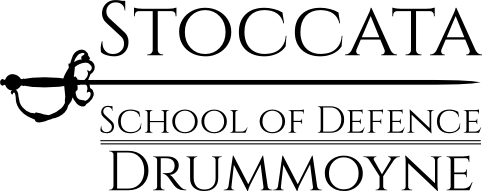
How to Book For Class
Class entry is strictly by booking only and is limited to 20 students plus instructors. Your booking information will be used only for record keeping required for lesson billing or for contact purposes, and is only available to the class instructors. Bookings can be made using the Online Booking Form.
Please note that as per the Stoccata risk management policy, classes are only open to people fully vaccinated against Covid-19.
Covid-19 Policy
The Branch has implemented a Covid-19 Policy in response to the current pandemic. The policy can be found at Stoccata Drummoyne Covid-19 Policy.
About Our Classes
Our classes in Drummoyne & Rhodes specialise in teaching historical Italian fencing systems, and are led by Provost Richard Cullinan. Systems being taught are Classical Italian Fencing, Italian Greatsword & Polearms, Italian Rapier, Scherma Bolognese, and Italian Knightly Combat. All our classes are based on the actual historical texts that outline how to use these various weapons. See the system descriptions below for more information. You can find out more about how the branch operates in our Stoccata Drummoyne Handbook.
Richard also keeps a blog of his fencing research at www.renfence.com.au
Systems We Teach
Scherma Bolognese
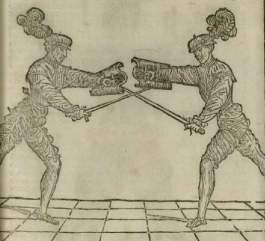 Scherma Bolognese is a catch all term used to describe the fencing systems described by various authors in and around the city of Bologna during the 16th Century. It is a cut and thrust sword system typically associated with the sidesword, a straight double edged sword between 81-94 cm (32″-37″) length, and with varying degrees of hilt complexity. The system as described also has other companion weapons such as the buckler, dagger, rotella, targa, cape, or even two swords. Our Scherma Bolognese sources are Antonio Manciolino’s Opera Nova and Achille Marozzo’s Opera Nova. Students will learn the sword & buckler, sword alone, and sword and dagger weapons combinations. More information can be found in our Scherma Bolognese Training Manual.
Scherma Bolognese is a catch all term used to describe the fencing systems described by various authors in and around the city of Bologna during the 16th Century. It is a cut and thrust sword system typically associated with the sidesword, a straight double edged sword between 81-94 cm (32″-37″) length, and with varying degrees of hilt complexity. The system as described also has other companion weapons such as the buckler, dagger, rotella, targa, cape, or even two swords. Our Scherma Bolognese sources are Antonio Manciolino’s Opera Nova and Achille Marozzo’s Opera Nova. Students will learn the sword & buckler, sword alone, and sword and dagger weapons combinations. More information can be found in our Scherma Bolognese Training Manual.
Classical Italian Fencing
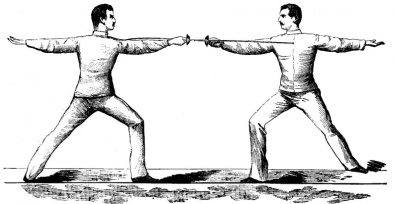 Our classical Italian fencing program teaches Italian swordsmanship from the 19th Centuries, and includes the following weapons: Duelling Sword, Duelling Sabre, and Bastone. The duelling sword was the straight thrusting sword of the 19th century, descended from the European small sword or rapier. These classes are taught using the Italian Fioretto (foil) or spada / spada de marra. Our duelling sword source is Masaniello Parise’s Trattato Terico-Practico della Sherma di Spada e Sciabola, the official curriculum of the Italian Military Fencing Masters School from the 1880s. The duelling sabre is the typical European fencing sabre of the 19th Century, and is taught using modern fencing sabres or reproduction training sabres. Our duelling sabre source is Luigi Barbasetti’s The Art of the Sabre and Epee. Both our duelling sword and duelling sabre material is supplemented with William Gaugler’s The Science of Fencing. Our bastone material is sourced from the 19th Century staff fencing system of Guiseppe Cerri (Trattato teorico-pratico della scherma di bastone, 1854). More information can be found in our Classical Italian Fencing Training Manual.
Our classical Italian fencing program teaches Italian swordsmanship from the 19th Centuries, and includes the following weapons: Duelling Sword, Duelling Sabre, and Bastone. The duelling sword was the straight thrusting sword of the 19th century, descended from the European small sword or rapier. These classes are taught using the Italian Fioretto (foil) or spada / spada de marra. Our duelling sword source is Masaniello Parise’s Trattato Terico-Practico della Sherma di Spada e Sciabola, the official curriculum of the Italian Military Fencing Masters School from the 1880s. The duelling sabre is the typical European fencing sabre of the 19th Century, and is taught using modern fencing sabres or reproduction training sabres. Our duelling sabre source is Luigi Barbasetti’s The Art of the Sabre and Epee. Both our duelling sword and duelling sabre material is supplemented with William Gaugler’s The Science of Fencing. Our bastone material is sourced from the 19th Century staff fencing system of Guiseppe Cerri (Trattato teorico-pratico della scherma di bastone, 1854). More information can be found in our Classical Italian Fencing Training Manual.
Italian Knightly Combat
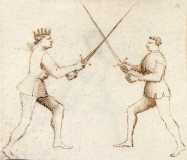 Our Italian Knightly Combat program teaches the arte delle armi, which is the martial art of the 15th Century knight or man at arms. This system teaches the arts of wrestling, the dagger, use of the longsword in one or two hands, pollaxe and spear. Our source are the works of Fiore Furlano de Cividale d’Austria, delli Liberi da Premariacco, who left us four illustrated versions of his text. Students start with the longsword and with the wrestling or dagger material before incorporating the pollaxe and spear material. More information can be found in our Italian Knightly Combat Training Manual.
Our Italian Knightly Combat program teaches the arte delle armi, which is the martial art of the 15th Century knight or man at arms. This system teaches the arts of wrestling, the dagger, use of the longsword in one or two hands, pollaxe and spear. Our source are the works of Fiore Furlano de Cividale d’Austria, delli Liberi da Premariacco, who left us four illustrated versions of his text. Students start with the longsword and with the wrestling or dagger material before incorporating the pollaxe and spear material. More information can be found in our Italian Knightly Combat Training Manual.
Italian Rapier
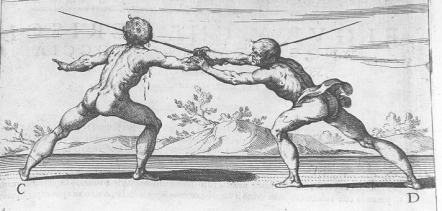 The Italian Rapier training program concentrates on the early 17th Century fencing systems described by Nicolleto Giganti (Scola, overo, teatro, Venice 1606, and Libro Secondo di Niccoletto Giganti Venetiano, Pisa 1608) and Ridolfo Capoferro (Gran Simulacro dell’arte e dell’usco della Scherma, Siena 1610). The Italian rapier is a straight double edged sword, typically with some form of complex hilt and possessing a blade of between 94-107cm (37″-42″). Italians were noted for their skill with this weapon from the 17th through to 19th centuries. Students start with the single rapier, adding rapier & dagger and rapier & cape as they progress. More information can be found in our Italian Rapier Training Manual.
The Italian Rapier training program concentrates on the early 17th Century fencing systems described by Nicolleto Giganti (Scola, overo, teatro, Venice 1606, and Libro Secondo di Niccoletto Giganti Venetiano, Pisa 1608) and Ridolfo Capoferro (Gran Simulacro dell’arte e dell’usco della Scherma, Siena 1610). The Italian rapier is a straight double edged sword, typically with some form of complex hilt and possessing a blade of between 94-107cm (37″-42″). Italians were noted for their skill with this weapon from the 17th through to 19th centuries. Students start with the single rapier, adding rapier & dagger and rapier & cape as they progress. More information can be found in our Italian Rapier Training Manual.
Italian Greatsword & Polearms
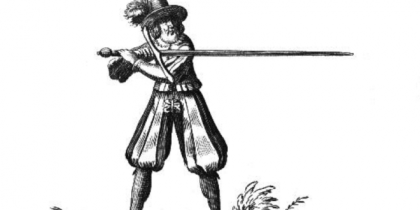 The Italian Greatsword or spadone is a true two handed sword, and one of the only true battlefield weapons taught at Stoccata. This weapon is typically anywhere from 5 to 6 feet, and usually 2.5-3 kg in weight. Our greatsword sources are Francesco Alfieri’s Lo Spadone from 1653, one of the few texts to deal exclusively with this weapon, and Achille Marozzo’s Opera Nova. Our polearm material covers partisan, speido, javelin, and ronca, and is sourced from Antonio Manciolino’s Opera Nova and Achille Marozzo’s Opera Nova. Advanced students will also learn the 19th Century staff fencing system of Guiseppe Cerri (Trattato teorico-pratico della scherma di bastone, 1854). More information can be found in our Greatsword and Italian Polearms Training Manual.
The Italian Greatsword or spadone is a true two handed sword, and one of the only true battlefield weapons taught at Stoccata. This weapon is typically anywhere from 5 to 6 feet, and usually 2.5-3 kg in weight. Our greatsword sources are Francesco Alfieri’s Lo Spadone from 1653, one of the few texts to deal exclusively with this weapon, and Achille Marozzo’s Opera Nova. Our polearm material covers partisan, speido, javelin, and ronca, and is sourced from Antonio Manciolino’s Opera Nova and Achille Marozzo’s Opera Nova. Advanced students will also learn the 19th Century staff fencing system of Guiseppe Cerri (Trattato teorico-pratico della scherma di bastone, 1854). More information can be found in our Greatsword and Italian Polearms Training Manual.
2024 Dates
Tuesdays
Term 1: 30 January – 9 April
Term 2: 30 April – 2 July
Term 3: 23 July – 24 September (No class 3 & 10 August due to hall use for elections)
Term 4: 15 October – 17 December
Wednesdays
Term 1: 31 January – 10 April
Term 2: 1 May – 3 July
Term 3: 24 July – 25 September (No class 4 & 11 August due to hall use for elections)
Term 4: 16 October – 18 December
Location
Tuesdays
Canada Bay Civic Hall, 1a Marlborough Street, Drummoyne
(There’s parking across the road in the shopping centre car park)
Wednesdays
Rhodes Community Centre, 63 Blaxland Road, Rhodes
Schedule
Tuesdays
7.30 – 9.30 pm – Classical Italian Fencing, Italian Greatsword & Polearms, Italian Rapier
Wednesdays
7.30 – 9.30 pm – Scherma Bolognese, Italian Knightly Combat
Costs
$150 per 10 week term (1 night per week)
Casual rate: $25 per night
Discounts for students and unemployed are available upon request.
Fees for the class may be paid via direct deposit. Banking details will be supplied when you book into the class.
An annual membership fee of $25 is also payable to the incorporated body. If you attend multiple branches, you need only pay the membership fee once.
Further Information
Further information regarding our branch and the programs taught at Stoccata Drummoyne can be found in the Stoccata Drummoyne Handbook.
Contact Information
Contact Richard Cullinan for more information or to book into the class.
PH: 0407 917 497
Or contact us using the form below

